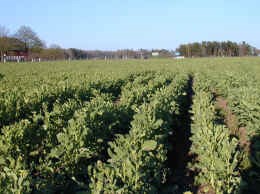Contact
maria.stenberg@slu.se, +46 511 67 274

A study of nitrogen sources, time of application and incorporation techniques
Project manager: Maria Stenberg, Department of Soil and Environment, SLU.
Project group: Lena Engström, SLU, Ingemar Gruvaeus, Hushållningssällskapet Skaraborg, Ann-Charlotte Wallenhammar, Hushållningssällskapet Örebro, Pär Johan Lööf, Svenska Lantmännen
The shift from 95 to 100% organically grown fodder for ruminants will further increase the need for organic oilseed products. The nitrogen (N) demand of a winter oilseed crop is large. Oilseed plant growth starts early in spring and during stem elongation in April and beginning of May, the net N mineralization in the soil is usually small.
Low yields in organic oilseed cropping may in most be related to low plant nutrient supply. It is important that organic fertilizers are added to the crop at a time when N utilization and N supply are optimal. The efficiency of commercial organic fertilizers needs to be investigated when these are added at low temperatures. There is a risk of slow N delivery and weak effect unless the fertilizer is incorporated and good soil contact can be provided, which is the case when organic fertilizers are added in spring to winter crops.
The aim of this study is to present sustainable strategies for N supply to winter oilseed rape with organic fertilizers at farms with or without animal production, and thereby increase the sustainability of crop production. Two hypotheses will be tested:
These hypotheses will be tested by investigation of several commercial organic fertilizers applied by different techniques in different plant densities. The correlation between organic fertilizer and conditions at spreading will be studied to analyse possibilities to influence factors that improve N delivery from the organic fertilizers and thereby increase their utilization efficiency. The project will be conducted in three field experiments per year over two years, the first experiment was established in August 2005.
maria.stenberg@slu.se, +46 511 67 274